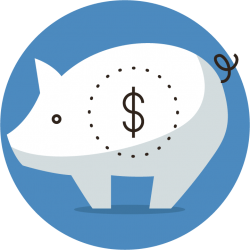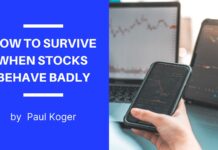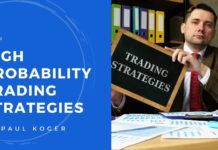Ok then, you’ve decided that you would like to start day trading and would like to adventure into this world. I just wish you good luck and let’s get started with this day trading guide!
But before that, let us begin with the day trading basics: what day trading is, how it works, and how much do you need for day trading.
What is Day Trading?
Day trading is a trading style, wherein you buy and sell a financial instrument on the same day (or multiple times within the day) on a trading platform. And if played correctly, this can be a lucrative game!
While all markets offer the potential for profit, just a word of advice, don’t attempt to master all of these markets at once. Why? It’s because it may take you the longer route to make money in day trading. After all, you are dividing your precious time and attention.
Familiarize yourself with one market and focus learning on that market. Be patient. And only when you learn to make money on that market will it be easier to adapt as well as learn other markets.
Different day trading markets
In a nutshell, the popular day trading markets you can choose from are the stock market, futures, and forex exchange market.
Day trading in the stock market needs at least a $25,000 brokerage balance. So, this makes it a capital-intensive option.
On the other hand, the trading futures market may need only $1,000 capital. This one I can recommend as well as foreign exchange market (requires the least investment/capital), where you are trading currencies, like EUR/USD currency pairs.
How Does Day Trading Work?
Let me tell you first that it is a rare feat to be a successful day trader. Even rarer if you are successful in this industry consistently. Why? Well, for one, it’s not easy to predict which stocks will move throughout the day.
A single wrong guess could have a cumulative effect, leading to hundreds or thousands of dollars lost in one bad trade. Some investors feel day trading is a roller coaster too, with lots of ups and downs!
But there are ways to lessen this psychological and emotional toll in day trading and become a successful day trader. A better way to invest (regardless of the amount of money) is to adopt day trading strategies.
Now, without further delay, here are day trading strategies that work for me and I hope it will work for you too! Ready to get started? Here we go!
Trading Strategy #1: Decide how much you are willing to invest
Now the first step is to decide how much you are willing to put into a trading account. The best recommendation that you can receive in this part is to only invest what you are willing to lose! This advice is super important and I honestly advise you to follow it.
The amount does not have to be huge, although most brokers require a hefty first deposit amount of 5000$ or more, luckily there are brokers available who have 100$ first deposit requirement.

Can you start day trading with $1000?
Yes, I would recommend starting with at least 1000$. The more you have, the easier it is to make some money, but this is a double-edged sword as you can also lose.
Most beginner traders do not have the 1000$ to start with, however, you can get a feel for the market with smaller sums as well.
But, can you also start day trading with $500?
Of course! Starting day trading with $500 will even offer you greater day trading flexibility and it will likely produce more income than investing with $100.
Trading Strategy #2: Open a real trading account
So now, as you have decided how much you are willing to invest in your day trading ventures (whether that be in the stock market, futures, or forex), the next thing you need to do is open a brokerage account.
As I mentioned before, most brokers require 5K$+ deposits or more, you would need to choose a broker that has smaller initial requirements.

Of course, if you are interested in putting down a larger amount, in the stock market for instance, then the potential list of account providers is a lot larger, but the broker I started with and still use is Etoro (read a review here). It is an Israeli social trading and multi-asset brokerage company.
Please remember, your capital is at risk. Only trade with money you can afford to lose.
Why those guys? I’ll list the reasons why I chose them and why I dare to recommend them:
- Their minimum deposit is super low, only 50$,
- They offer leverage up to 1:400,
- Loads of instruments to trade (forex, commodities, indices)
- No platform fees if you are an active trader,
- Many ways to fund your account,
- Very easy to use platforms,
- No commissions on trades (!)
- The possibility to copy successful traders with your account.
- You can do your research and technical analysis and find out which broker is the best for you, this is just my honest recommendation based on 3 years of experience.
Their website: www.etoro.com
Should you open a cash account or margin account?
Cash accounts and margin accounts are two primary types of brokerage accounts. In opening a cash brokerage account, you should use cash in paying for the securities that you want to buy.
On the other hand, a margin account is an account where you borrow money to acquire securities, like options, bonds, or stocks. Margin trading happens when traders use the borrowed funds from a broker.
When a broker asks for additional funds or securities into the account so it reaches the minimum value, it’s called a “margin call.”
Again by margin trading, you should be aware that you’ll have to pay the broker margin loan.
Trading Strategy #3: Choose your day trading strategies/strategy

Now what you need is a profitable and proven day trading strategy!
I have outlined several various day trading strategies and technical analysis (helpful in spotting trends) on my Day Trading Strategies page. Pick one that fits your day trading abilities time- and skill-wise.
All of them I have personally tested out and have been successful with. Also, check out my videos page to see those day trading techniques in action.
Having a profitable strategy is key to winning at trading, but there is a lot more to it than just the strategy. You need to practice and maintain a good psychological state of mind and have strong bankroll management to become profitable.
How much do day traders make a day?
I don’t want to make astronomical claims or outlandish promises to you. Experienced day traders often take their job seriously, sticking with their strategies, and are disciplined in what they do.
And anyone telling you that there’s an exact or definitive range of what you earn per day of day trading is more likely pulling your leg. The reason being, there are external factors that play into the amount of money you make in day trading.
But of course, profitable day trading techniques, approaches, systems are there but they take time to develop. Risk management also comes into play that day traders can make use of.
As a day trader (beginner), if you start with $1,000, you should know that your earning potential is far less than a day trader who began with $10,000.
Day trading stocks
In this guide on how to start day trading, the amount of money you can potentially make day trading stocks would be $5,500/month or an 18% monthly return. Take note, this is only an estimate since you need to have at least $25,000 in your account to day trade stocks.
If you want to day trade above the $25,000 threshold, then you can begin with $30,000. Considering a proper risk management strategy to cut down losses, the absolute amount you can risk on everyday trade would be $300 or 1% of $30,000.
Then, your stop loss would be $0.10. A good trading platform will allow you to win 50% of the time so you can average 5-day trades every day. Now, if you have an average of 20 day trading days within one month, you can make about 100 trades monthly.
50 of these trades would be profitable and 50 would be unprofitable. Deduct your net to your commission costs, including trading platform or charting platform and exchange entitlements. Roughly, you get about $5,500/month.
Day trading futures
Buying and selling futures may allow you as a day trader to earn approximately $2750/month. The formula is finding five-day trades in a day that offer you reward: risk.
Day trading forex
Meanwhile, if you are day trading forex (trading currencies, like EUR/USD), you can risk 1% of your capital. Say, you started as a day trader with as little as $100.
Each pip (percentage in point) of movement in the forex market could result in a $10 loss or gain if you day trade in a standard lot (equivalent to 100,000 units of the base currency).
More or less, day traders can net $1,254 trading in the forex market.
I like this market for day traders because you have enough time throughout the day to conduct a technical analysis, execute, and then monitor your day trade.
Day trader salaries
Now, let’s brighten things up a little and look at some of the big players in the capital market of day trading.
Top traders in Citi can get as much as $435k per day or $154,260 per year. Bank of America’s top traders can also get at a nice $275k per day or $146,906 per year.
Day trader salary at Morgan Stanley stands out at $276k per day. Take note, these are individual day trading salaries.
Trading Strategy #4: Feel Like You’re Ready as a Day Trader? Practice Using a Trading Simulator
Many novice day traders fail to recognize and understand that it takes time and practice to learn day trading as much as it does with being familiar with the theory. You don’t just become a successful day trader in one day.
You may even have to practice day trading using a demo account while still maintaining your day job, especially if you don’t have a budget set aside to cover your expenses in the next few months or so.
Using a day-trading simulator or a demo account will greatly help because it is risk-free and you get to develop your confidence in trading strategies you adopt and your day trade decisions.
I elaborate on these topics a bit more in my article section. Read as much as you can and practice becoming a better day trader every day! 🙂
Oh, and remember, for you to be a successful day trader =)










![Etoro Review – My Honest Opinion [+TUTORIALS]](https://foxytrades.com/wp-content/uploads/2018/03/Etoro-Review-100x70.jpg)

What broker is best for residence in Texas or California, Etoro not registered in either.